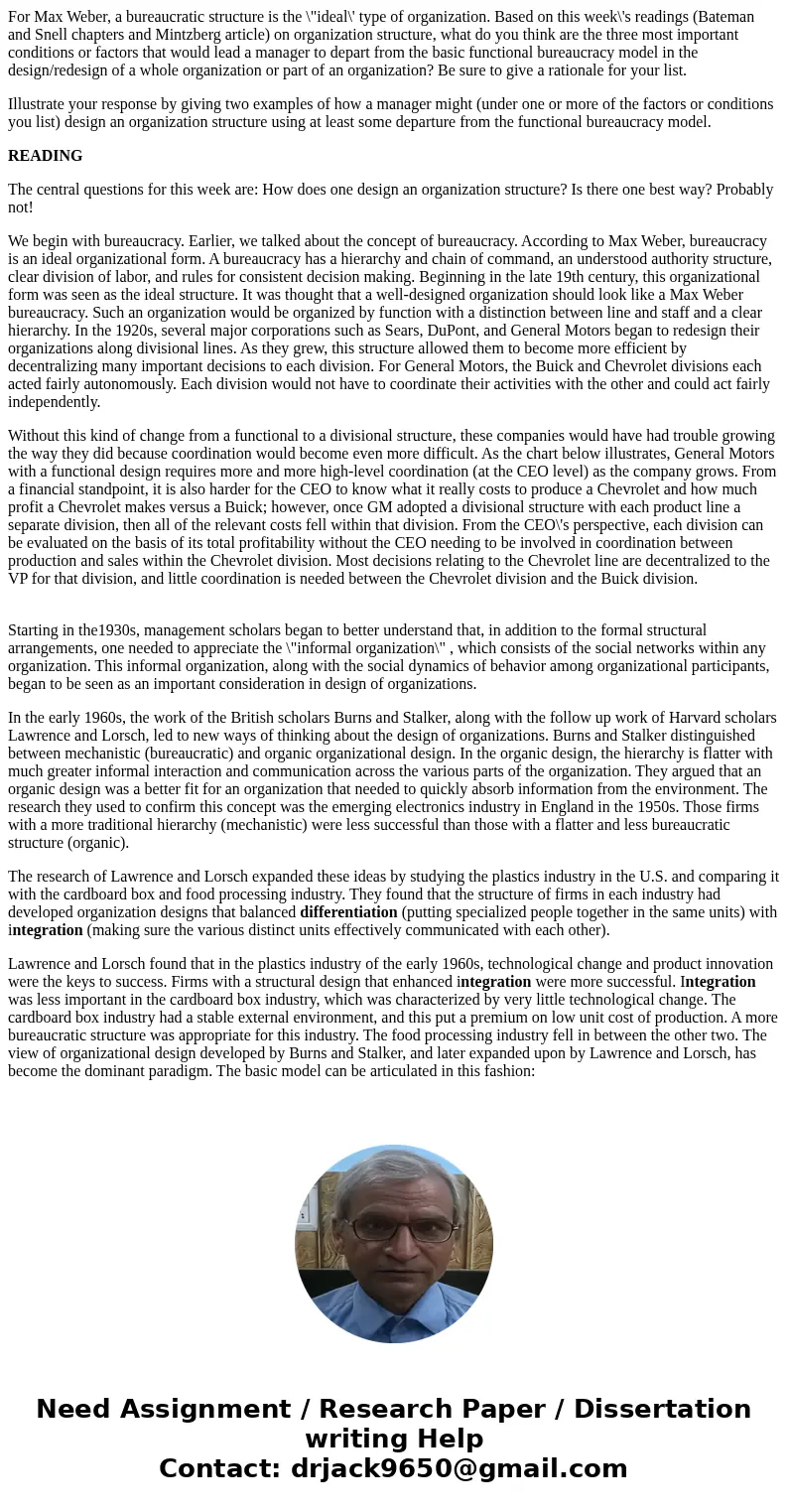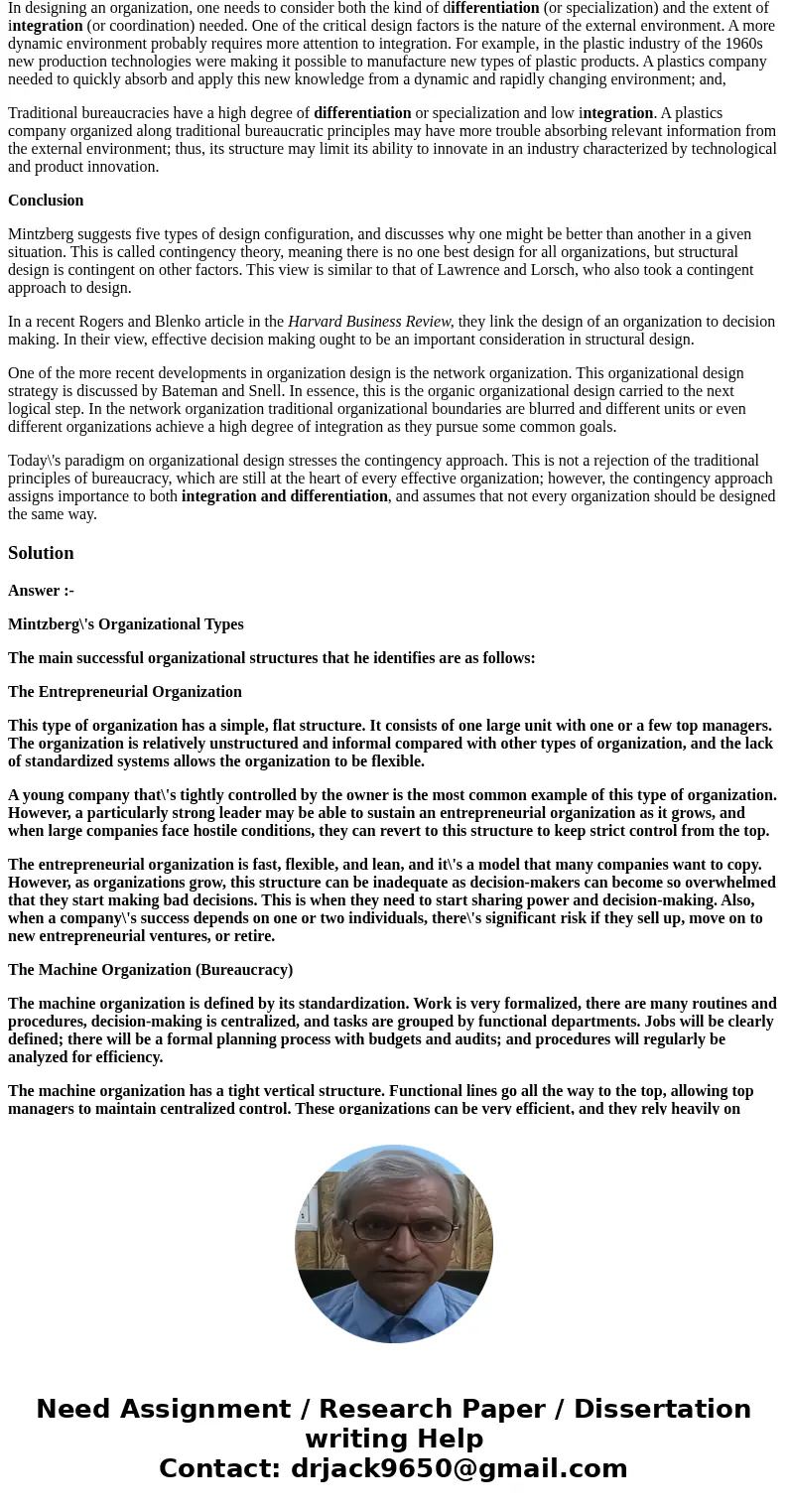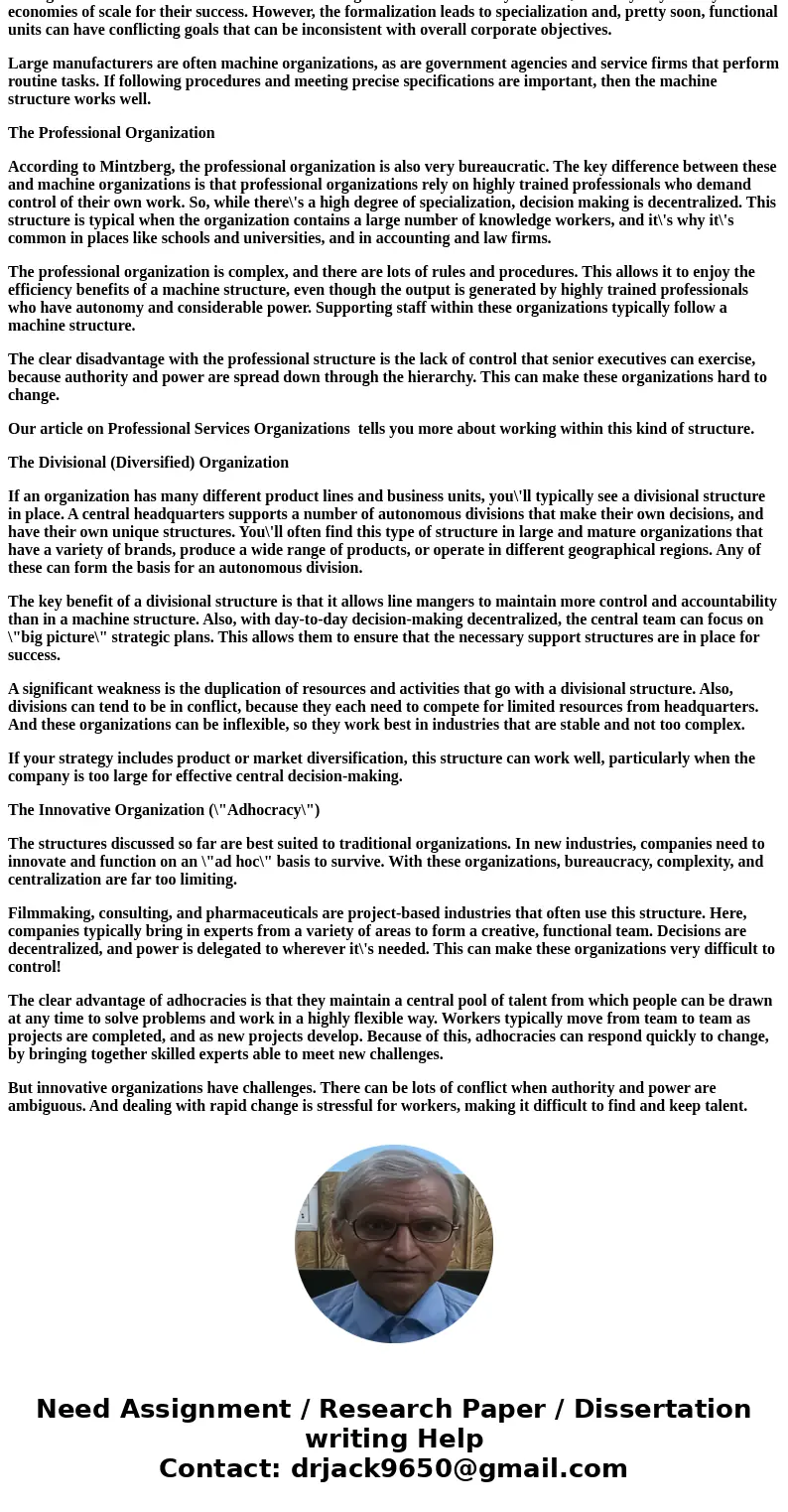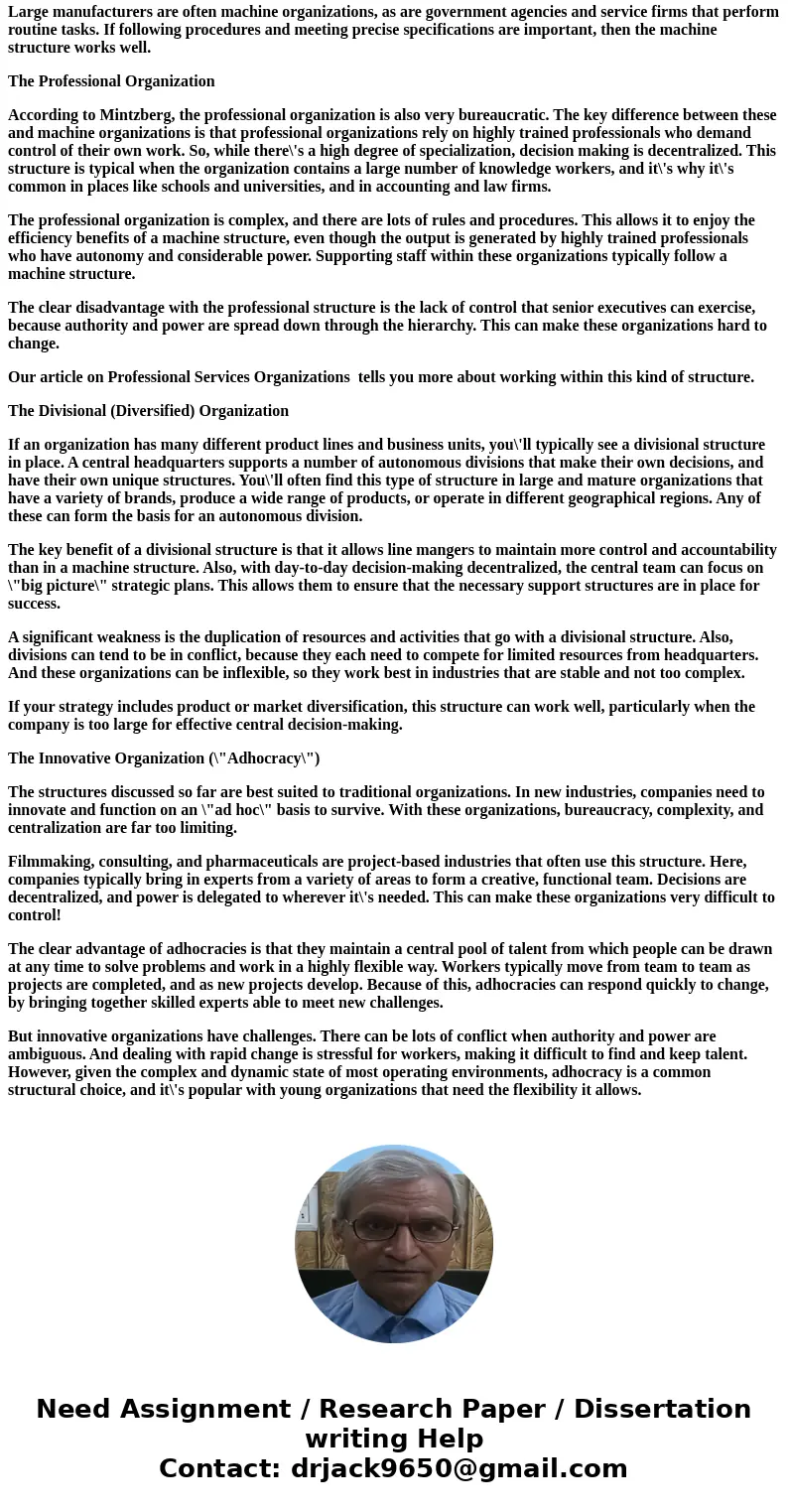For Max Weber a bureaucratic structure is the ideal type of
For Max Weber, a bureaucratic structure is the \"ideal\' type of organization. Based on this week\'s readings (Bateman and Snell chapters and Mintzberg article) on organization structure, what do you think are the three most important conditions or factors that would lead a manager to depart from the basic functional bureaucracy model in the design/redesign of a whole organization or part of an organization? Be sure to give a rationale for your list.
Illustrate your response by giving two examples of how a manager might (under one or more of the factors or conditions you list) design an organization structure using at least some departure from the functional bureaucracy model.
READING
The central questions for this week are: How does one design an organization structure? Is there one best way? Probably not!
We begin with bureaucracy. Earlier, we talked about the concept of bureaucracy. According to Max Weber, bureaucracy is an ideal organizational form. A bureaucracy has a hierarchy and chain of command, an understood authority structure, clear division of labor, and rules for consistent decision making. Beginning in the late 19th century, this organizational form was seen as the ideal structure. It was thought that a well-designed organization should look like a Max Weber bureaucracy. Such an organization would be organized by function with a distinction between line and staff and a clear hierarchy. In the 1920s, several major corporations such as Sears, DuPont, and General Motors began to redesign their organizations along divisional lines. As they grew, this structure allowed them to become more efficient by decentralizing many important decisions to each division. For General Motors, the Buick and Chevrolet divisions each acted fairly autonomously. Each division would not have to coordinate their activities with the other and could act fairly independently.
Without this kind of change from a functional to a divisional structure, these companies would have had trouble growing the way they did because coordination would become even more difficult. As the chart below illustrates, General Motors with a functional design requires more and more high-level coordination (at the CEO level) as the company grows. From a financial standpoint, it is also harder for the CEO to know what it really costs to produce a Chevrolet and how much profit a Chevrolet makes versus a Buick; however, once GM adopted a divisional structure with each product line a separate division, then all of the relevant costs fell within that division. From the CEO\'s perspective, each division can be evaluated on the basis of its total profitability without the CEO needing to be involved in coordination between production and sales within the Chevrolet division. Most decisions relating to the Chevrolet line are decentralized to the VP for that division, and little coordination is needed between the Chevrolet division and the Buick division.
Starting in the1930s, management scholars began to better understand that, in addition to the formal structural arrangements, one needed to appreciate the \"informal organization\" , which consists of the social networks within any organization. This informal organization, along with the social dynamics of behavior among organizational participants, began to be seen as an important consideration in design of organizations.
In the early 1960s, the work of the British scholars Burns and Stalker, along with the follow up work of Harvard scholars Lawrence and Lorsch, led to new ways of thinking about the design of organizations. Burns and Stalker distinguished between mechanistic (bureaucratic) and organic organizational design. In the organic design, the hierarchy is flatter with much greater informal interaction and communication across the various parts of the organization. They argued that an organic design was a better fit for an organization that needed to quickly absorb information from the environment. The research they used to confirm this concept was the emerging electronics industry in England in the 1950s. Those firms with a more traditional hierarchy (mechanistic) were less successful than those with a flatter and less bureaucratic structure (organic).
The research of Lawrence and Lorsch expanded these ideas by studying the plastics industry in the U.S. and comparing it with the cardboard box and food processing industry. They found that the structure of firms in each industry had developed organization designs that balanced differentiation (putting specialized people together in the same units) with integration (making sure the various distinct units effectively communicated with each other).
Lawrence and Lorsch found that in the plastics industry of the early 1960s, technological change and product innovation were the keys to success. Firms with a structural design that enhanced integration were more successful. Integration was less important in the cardboard box industry, which was characterized by very little technological change. The cardboard box industry had a stable external environment, and this put a premium on low unit cost of production. A more bureaucratic structure was appropriate for this industry. The food processing industry fell in between the other two. The view of organizational design developed by Burns and Stalker, and later expanded upon by Lawrence and Lorsch, has become the dominant paradigm. The basic model can be articulated in this fashion:
In designing an organization, one needs to consider both the kind of differentiation (or specialization) and the extent of integration (or coordination) needed. One of the critical design factors is the nature of the external environment. A more dynamic environment probably requires more attention to integration. For example, in the plastic industry of the 1960s new production technologies were making it possible to manufacture new types of plastic products. A plastics company needed to quickly absorb and apply this new knowledge from a dynamic and rapidly changing environment; and,
Traditional bureaucracies have a high degree of differentiation or specialization and low integration. A plastics company organized along traditional bureaucratic principles may have more trouble absorbing relevant information from the external environment; thus, its structure may limit its ability to innovate in an industry characterized by technological and product innovation.
Conclusion
Mintzberg suggests five types of design configuration, and discusses why one might be better than another in a given situation. This is called contingency theory, meaning there is no one best design for all organizations, but structural design is contingent on other factors. This view is similar to that of Lawrence and Lorsch, who also took a contingent approach to design.
In a recent Rogers and Blenko article in the Harvard Business Review, they link the design of an organization to decision making. In their view, effective decision making ought to be an important consideration in structural design.
One of the more recent developments in organization design is the network organization. This organizational design strategy is discussed by Bateman and Snell. In essence, this is the organic organizational design carried to the next logical step. In the network organization traditional organizational boundaries are blurred and different units or even different organizations achieve a high degree of integration as they pursue some common goals.
Today\'s paradigm on organizational design stresses the contingency approach. This is not a rejection of the traditional principles of bureaucracy, which are still at the heart of every effective organization; however, the contingency approach assigns importance to both integration and differentiation, and assumes that not every organization should be designed the same way.
Solution
Answer :-
Mintzberg\'s Organizational Types
The main successful organizational structures that he identifies are as follows:
The Entrepreneurial Organization
This type of organization has a simple, flat structure. It consists of one large unit with one or a few top managers. The organization is relatively unstructured and informal compared with other types of organization, and the lack of standardized systems allows the organization to be flexible.
A young company that\'s tightly controlled by the owner is the most common example of this type of organization. However, a particularly strong leader may be able to sustain an entrepreneurial organization as it grows, and when large companies face hostile conditions, they can revert to this structure to keep strict control from the top.
The entrepreneurial organization is fast, flexible, and lean, and it\'s a model that many companies want to copy. However, as organizations grow, this structure can be inadequate as decision-makers can become so overwhelmed that they start making bad decisions. This is when they need to start sharing power and decision-making. Also, when a company\'s success depends on one or two individuals, there\'s significant risk if they sell up, move on to new entrepreneurial ventures, or retire.
The Machine Organization (Bureaucracy)
The machine organization is defined by its standardization. Work is very formalized, there are many routines and procedures, decision-making is centralized, and tasks are grouped by functional departments. Jobs will be clearly defined; there will be a formal planning process with budgets and audits; and procedures will regularly be analyzed for efficiency.
The machine organization has a tight vertical structure. Functional lines go all the way to the top, allowing top managers to maintain centralized control. These organizations can be very efficient, and they rely heavily on economies of scale for their success. However, the formalization leads to specialization and, pretty soon, functional units can have conflicting goals that can be inconsistent with overall corporate objectives.
Large manufacturers are often machine organizations, as are government agencies and service firms that perform routine tasks. If following procedures and meeting precise specifications are important, then the machine structure works well.
The Professional Organization
According to Mintzberg, the professional organization is also very bureaucratic. The key difference between these and machine organizations is that professional organizations rely on highly trained professionals who demand control of their own work. So, while there\'s a high degree of specialization, decision making is decentralized. This structure is typical when the organization contains a large number of knowledge workers, and it\'s why it\'s common in places like schools and universities, and in accounting and law firms.
The professional organization is complex, and there are lots of rules and procedures. This allows it to enjoy the efficiency benefits of a machine structure, even though the output is generated by highly trained professionals who have autonomy and considerable power. Supporting staff within these organizations typically follow a machine structure.
The clear disadvantage with the professional structure is the lack of control that senior executives can exercise, because authority and power are spread down through the hierarchy. This can make these organizations hard to change.
Our article on Professional Services Organizations tells you more about working within this kind of structure.
The Divisional (Diversified) Organization
If an organization has many different product lines and business units, you\'ll typically see a divisional structure in place. A central headquarters supports a number of autonomous divisions that make their own decisions, and have their own unique structures. You\'ll often find this type of structure in large and mature organizations that have a variety of brands, produce a wide range of products, or operate in different geographical regions. Any of these can form the basis for an autonomous division.
The key benefit of a divisional structure is that it allows line mangers to maintain more control and accountability than in a machine structure. Also, with day-to-day decision-making decentralized, the central team can focus on \"big picture\" strategic plans. This allows them to ensure that the necessary support structures are in place for success.
A significant weakness is the duplication of resources and activities that go with a divisional structure. Also, divisions can tend to be in conflict, because they each need to compete for limited resources from headquarters. And these organizations can be inflexible, so they work best in industries that are stable and not too complex.
If your strategy includes product or market diversification, this structure can work well, particularly when the company is too large for effective central decision-making.
The Innovative Organization (\"Adhocracy\")
The structures discussed so far are best suited to traditional organizations. In new industries, companies need to innovate and function on an \"ad hoc\" basis to survive. With these organizations, bureaucracy, complexity, and centralization are far too limiting.
Filmmaking, consulting, and pharmaceuticals are project-based industries that often use this structure. Here, companies typically bring in experts from a variety of areas to form a creative, functional team. Decisions are decentralized, and power is delegated to wherever it\'s needed. This can make these organizations very difficult to control!
The clear advantage of adhocracies is that they maintain a central pool of talent from which people can be drawn at any time to solve problems and work in a highly flexible way. Workers typically move from team to team as projects are completed, and as new projects develop. Because of this, adhocracies can respond quickly to change, by bringing together skilled experts able to meet new challenges.
But innovative organizations have challenges. There can be lots of conflict when authority and power are ambiguous. And dealing with rapid change is stressful for workers, making it difficult to find and keep talent. However, given the complex and dynamic state of most operating environments, adhocracy is a common structural choice, and it\'s popular with young organizations that need the flexibility it allows.




 Homework Sourse
Homework Sourse